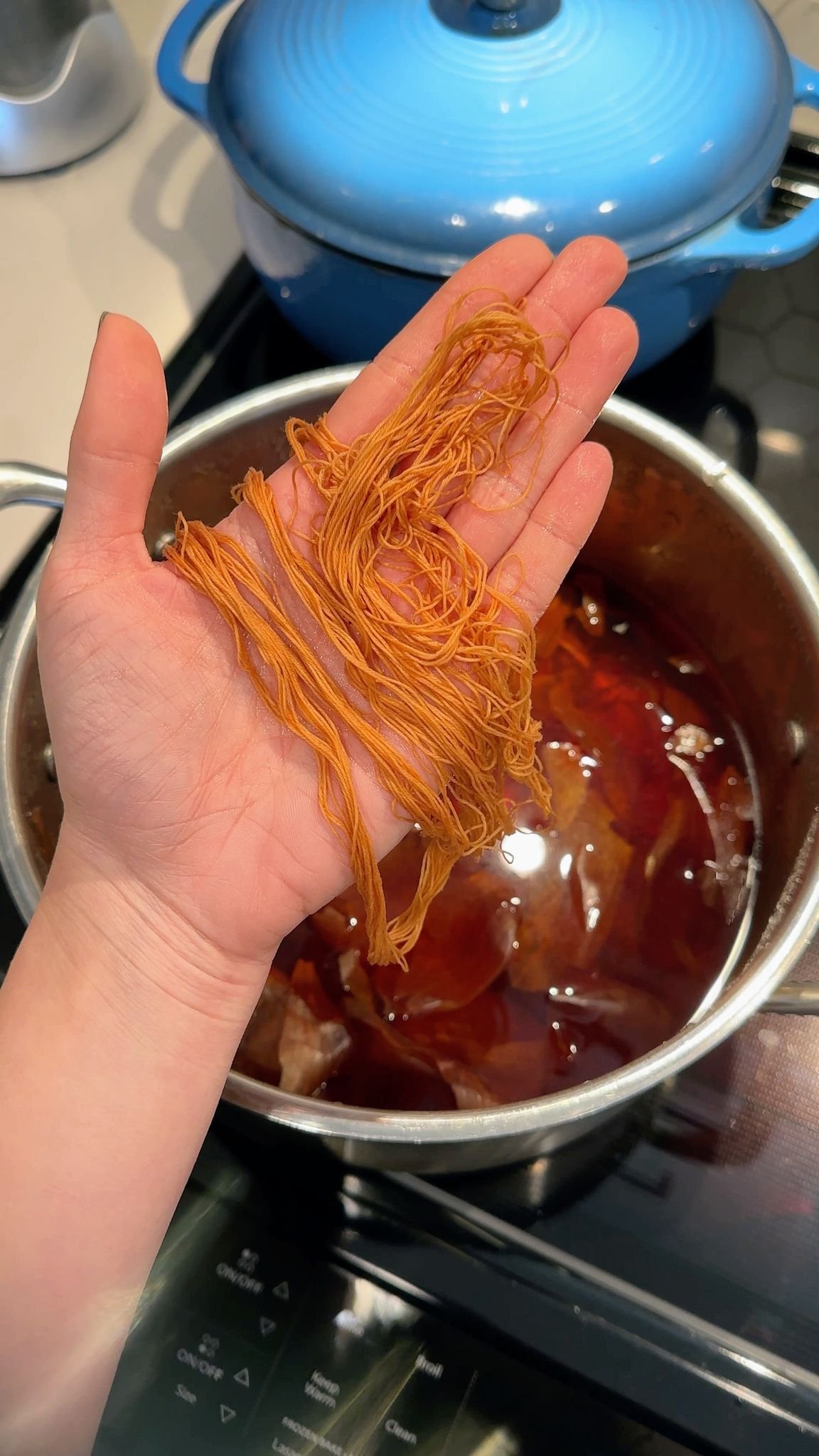Onion Skins & Patience: A Lesson in Dyeing and Detachment
I didn’t expect that boiling onion skins with a few friends would make me rethink control, but here we are.
The Surprise That Starts in a Pot
I thought I was just facilitating a simple hand-dyeing workshop.
We had gathered—virtually, over Zoom—in the Tatreez Lab, a small group of us staring into pots that had been quietly steeping onion skins in what our guide, Fatima of Abuelita Fiber Company, calls an “onion bath.” The concept was simple: use something you’d normally toss—onion peels—to color thread we could later stitch with.
But what unfolded was anything but simple.
I’ll admit—I had been dreading the prep. I kept wondering if the small supermarket near me would think I was stealing as I hovered over the onion bins collecting loose skins. Then came the uncertainty: was I boiling them correctly? Was the water hot enough? Was this actually working?
I had to put my full trust in Fatima’s steps—steps rooted in ancestral knowledge I was just beginning to touch. And then, when it came time to dye our threads live together, there was no turning back. We dipped, rinsed, dried, rinsed again. It felt both sacred and awkward. Like following a recipe in a language you almost—but don’t quite—understand.
And still, somehow, when the golden hues began to bloom in our pots, something deeper stirred.
This wasn’t just about dyeing thread. It was about learning to release control. To be surprised. To reconnect.
To let go.
What Natural Dyeing Really Teaches You
There’s this illusion that because you’re the one holding the pot, you're in control. But that’s not how nature works.
When you dye naturally, especially with food waste like onion skins, so many things affect the outcome:
The pH of your tap water
The material of your pot
Whether you soaked the thread first
The time you let it steep
The onions and quantity of onions where the skins came from
You can follow the same steps with someone next to you and still get a completely different result.
That’s both maddening—and magical.
The act of dyeing becomes a mirror. You think you’re just trying to get a color. But what you’re really doing is practicing surrender. Practicing trust. Practicing reverence.
The Culture of Control vs. The Culture of Craft
We live in a world where you can click a button and something arrives the next day. We’re taught to expect consistency, efficiency, and perfection.
But in our rush for convenience, we’ve lost our tolerance for mystery. For patience. For process.
Natural dyeing doesn’t let you skip the steps. There’s no way to "expedite" an extract. You can’t demand exactness from a plant. You have to listen—to the fiber, to the water, to the heat.
In a way, it reminds me of tatreez. You can’t rush it. You can’t copy and paste a thobe. Every stitch takes time. Every thread has a story. And if you try to push or perfect too hard, you lose something sacred in the process.
Why I Believe Everyone Should Dye Something—At Least Once
Here’s the thing: I’m not saying we all need to be dyeing everything in our closet. Or that we need to know and witness the full process from natural material to what we then put on our back or use in our everday.
But I do think everyone should try it, even just once.
Because when you do, you realize how much of your wardrobe you’ve taken for granted. You start to wonder where color comes from. Who made this? What chemicals touched this? What land or labor was exploited in the process?
You start to ask better questions—and that alone is a shift.
You begin to care again.
Building a Relationship With What You Wear (And Who You Are)
What this workshop opened up for me was more than just an appreciation for color—it was a small step back toward something sacred. A relationship with land. With time. With the way my ancestors once made things.
I realized how much of modern life is about detachment: from where our food comes from, where our clothes come from, even where our own feelings come from.
But dyeing—with food scraps no less!—felt like a return. A grounding.
It reminded me that slow is not broken. Imperfect is not failure. And when we create something together, with our hands and hearts open, we get to reconnect with what’s been stripped away.
The (Dyed) Thread That’s Leading Me Home
That day in the Tatreez Lab, as we held up our freshly dyed thread—some gold, some rust, some barely changed—we couldn’t stop smiling.
Not because the colors were perfect.
But because they were ours.
In this world that rewards speed, precision, and sameness, we chose slow, messy, and one-of-a-kind. We made something with the earth. We made something from the earth.
And that’s a thread I want to keep following.

